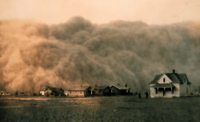
Photo from wikipedia
Summary Flash fires and explosions in areas containing an enriched combustible dust atmosphere are a major safety concern in industrial processing. An experimental study was conducted to analyse the effects… Click to show full abstract
Summary Flash fires and explosions in areas containing an enriched combustible dust atmosphere are a major safety concern in industrial processing. An experimental study was conducted to analyse the effects of atmospheric coal dust particle sizes and concentrations on the minimum auto-ignition temperature (MAIT) of a dust cloud. Two different coal samples from Australian coal mines were used. The coal dust particles were prepared and sized in 3 ranges, of below 74 μm, 74 to 125 μm and 125 to 212 μm, by using a series of sieves and a sieve shaker. A humidifier was used to increase the moisture content of the particles to the required level. All the experiments were conducted in accordance with the ASTM E1491-06 method in a calibrated Goldbert-Greenwald furnace. The results from this study indicate that coal dust properties, such as the chemical nature (H/C), concentration, particle size (D50), and moisture content, impact on the MAIT. For coal dust concentrations less than 1000 g.m−3, the MAIT decreases with increasing coal dust concentrations. On the other hand, for low concentrations of 100 to 15 g.m−3, the MAIT becomes more reliable for particle size D50 rather than for volatile matters.
Journal Title: Fire and Materials
Year Published: 2017
Link to full text (if available)
Share on Social Media: Sign Up to like & get
recommendations!